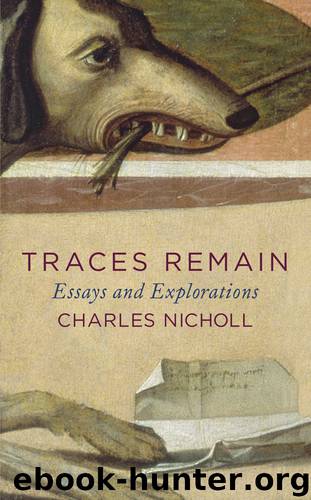Traces Remain by Charles Nicholl

Author:Charles Nicholl [Nicholl, Charles]
Language: eng
Format: epub
ISBN: 9780141922294
Publisher: Penguin Books Ltd
Published: 2011-11-03T16:00:00+00:00
And here is a literary joke: ‘If Petrarch was so madly in love with bay leaves, it’s because they taste so good with sausage and thrush,’ punning on lauro, the bay tree, and Laura, to whom Petrarch’s love-poems are addressed. To our ears these jokes are not very funny, but they carry a far-off sound of laughter which we might otherwise forget to listen for.
13
The Secrets of St Proculus
A Reattribution
[1999]
In the former fabbriceria, or works department, of the Basilica di San Petronio in Bologna stands a white marble statue. It represents the Christian martyr St Proculus, who was beheaded in Bologna in AD 19 and is one of the city’s favourite saints. According to the conventional wisdom it was sculpted in the late 1520s, precisely here in the fabbriceria, by a jobbing sculptor named Alfonso Lombardi.
If you crouch down below the saint and peer up between his legs – a procedure that is best managed alone, for fear of offending local sensibilities – you can see a horizontal line, where the tasselled hem of his tunic overhangs his smooth muscular thighs. The question is: is this line a mere indentation, or is it a join of two separate pieces of marble? The art historian and archaeologist Mario Pincherle says it is the latter – he claims to have slid the blade of a knife into it, one day in the 1970s. I am unable to repeat this experiment and so remain uncertain. According to Pincherle only the bottom half of the sculpture is by Lombardi. The top half, he believes, is the work of the young Michelangelo.
It is documented that Michelangelo visited Bologna in late 1494, at the age of nineteen, and stayed there several months. He sculpted at least two of the figures on the reliquary ark in the church of San Domenico, for which he was paid twelve scudi. But these are small works, around two feet tall. If Pincherle is right about the St Proculus statue, it would be the earliest life-size sculpture by Michelangelo in existence.
I knew nothing of this when I first met Pincherle last year, in a cheerful restaurant called La Baita, set among the chestnut woods of Monte Serra in northern Tuscany, and known for its down-home dishes of hare and wild boar. He is a short, magisterial figure with a shock of white curls, born into a Bolognese Jewish family of scientists and mathematicians, but now living in Tuscany. He will be eighty this year, and if his schedule goes according to plan he will publish his hundredth book. Art history is only one of his interests. His publications include various learned excursions into early biblical history, ancient languages, palaeotechnology and Egyptology. His best-known book is Il quinto Vangelo (‘The Fifth Gospel’), a translation of a Coptic manuscript attributed to the apostle St Thomas. He has also translated texts from Akkadian, the language of Mesopotamia, compared to which, he says, ‘Sanskrit is a recent invention.’
When he learned I was researching a book
Download
This site does not store any files on its server. We only index and link to content provided by other sites. Please contact the content providers to delete copyright contents if any and email us, we'll remove relevant links or contents immediately.
| Books & Reading | Comparative Literature |
| Criticism & Theory | Genres & Styles |
| Movements & Periods | Reference |
| Regional & Cultural | Women Authors |
4 3 2 1: A Novel by Paul Auster(11031)
The handmaid's tale by Margaret Atwood(6836)
Giovanni's Room by James Baldwin(5870)
Big Magic: Creative Living Beyond Fear by Elizabeth Gilbert(4716)
Asking the Right Questions: A Guide to Critical Thinking by M. Neil Browne & Stuart M. Keeley(4562)
On Writing A Memoir of the Craft by Stephen King(4204)
Ego Is the Enemy by Ryan Holiday(3982)
Ken Follett - World without end by Ken Follett(3968)
The Body: A Guide for Occupants by Bill Bryson(3788)
Bluets by Maggie Nelson(3704)
Adulting by Kelly Williams Brown(3662)
Guilty Pleasures by Laurell K Hamilton(3578)
Eat That Frog! by Brian Tracy(3505)
White Noise - A Novel by Don DeLillo(3429)
The Poetry of Pablo Neruda by Pablo Neruda(3357)
Alive: The Story of the Andes Survivors by Piers Paul Read(3300)
The Bookshop by Penelope Fitzgerald(3220)
The Book of Joy by Dalai Lama(3212)
Fingerprints of the Gods by Graham Hancock(3206)
